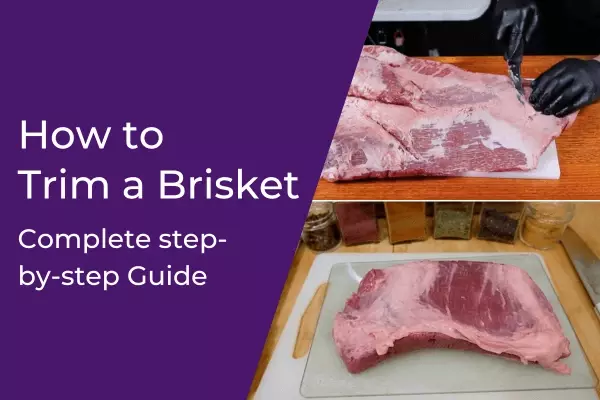How to Trim a Brisket – Complete Modern-day Guide
For those who are unfamiliar with cooking this tasty cut of meat, trimming a brisket can seem like a daunting task. The taste and texture of your brisket can be significantly improved by trimming away extra fat and silver skin, though. In this post, we’ll provide you with a step-by-step guide for trimming a brisket along with some helpful advice on how to speed up the procedure.

Following the instructions in this article will guarantee that your brisket is well-trimmed and prepared for the smoker or grill, whether of whether you are preparing it for a big occasion or simply cooking for your family. Let’s begin and discover how to trim a brisket like an expert!
Essential Tools for Trimming a Brisket:
It’s crucial to have the proper equipment while trimming a brisket. The correct tools will not only facilitate an easier and more effective process, but they will also guarantee that your brisket is well-trimmed and prepared for cooking.
Each instrument is essential to the trimming process, whether it is a sharp knife for fine cuts, kitchen shears for difficult-to-reach places, or a robust cutting board for stability. In order to make the task easier and more enjoyable, make sure you have all the required tools on hand before you begin cutting your brisket. Here are the basic tools you need to trim your Brisket
How to trim a brisket
Trimming is more than just getting rid of extra fat when it comes to getting a brisket ready for smoking or grilling. Moreover, the meat must be shaped to provide consistent cooking and a more appealing presentation.
You may make the brisket more oval-shaped and help ensure that the heat and smoke can travel over and around the meat, producing a more tender and tastier final product, by removing the smaller, thinner corner sections of the flat muscle
Here is a checklist of the specific steps to do when trimming a brisket:
You’ll be well on your way to cutting a flawlessly prepared brisket if you stick to these instructions. To ensure that your brisket cooks evenly and is tender and flavorful, it is crucial to take your time and trim carefully.
To Leave or Not to Leave Fat on Your Brisket: Debating the Pros and Cons
Others choose to chop off all visible fat for a more meat-focused flavor profile, even though some pitmasters believe by keeping a coating of fat on their brisket to insulate it from direct heat or baste it while it cooks. When determining whether or not to leave the fat on your brisket, keep the following in mind:
The decision to leave the fat on your brisket is ultimately a matter of taste. Try out several methods to determine which suits your palette and cooking style the best
Trimming a Brisket: (Home vs Competition vs Restaurant)
The way you trim a brisket will depend on what you want to achieve. You may wish to save as much meat as you can for home purposes and cut heavily to get rid of extra fat and silver skin. There are other things to think about whether you’re trimming for a restaurant or a competition, though.
In a restaurant, consistency is essential. Briskets must cook at the same time every day; thus, trimming must be done with a bit more care to maintain consistency in size. Since restaurants must turn a profit on their meat, yield is another important consideration.
Contrarily, competition trimming is unquestionably the most aggressive. The flat and point muscles are separated and trimmed to account for shrinkage during cooking because the brisket slices and burnt ends must fit inside a square 9″ hand-in container. Since pitmasters are only competing on the quality of the finished product, yield is not an issue. So, the trimming style might differ for home use, competition, and restaurant settings depending on your desired aim.
Frequently Asked Questions (FAQs)
Conclusion
In order to achieve the finest results while cooking this tough cut of meat, cutting a brisket is a crucial step. All you need to get started are the necessary tools, a sturdy cutting board, a sharp knife, and gloves. When trimming, keep in mind that it can take some practice to get it perfect. Take your time and be patient. It all depends on your personal preferences whether you want to leave some fat on or entirely take it off. Last but not least, knowing how to trim will help you attain consistency and maximize your meat supply for various purposes, such as contests or restaurants. You can roast a tasty, expertly cut brisket every time by using these techniques and recommendations.
